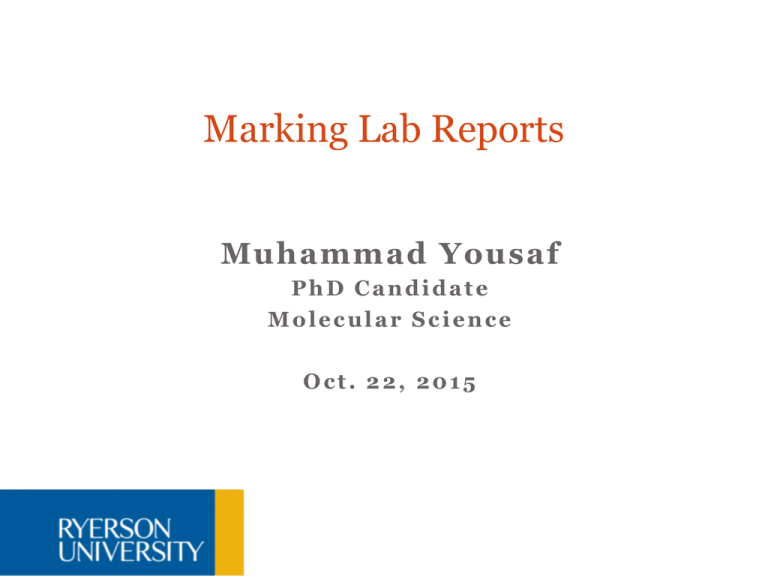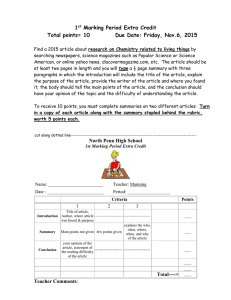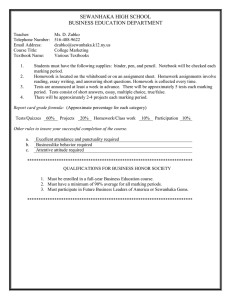Marking Lab Reports - Ryerson University
advertisement

Marking Lab Reports Muhammad Yousaf PhD Candidate Molecular Science Oct. 22, 2015 Introduction Name Department MSc or PhD (year of study) Learning and teaching level ……… Expectations and motivations 2 Outline Learning outcomes Major concerns on marking TA’s expectations and Student’s expectations Concerns about plagiarism Marking the lab reports (criteria/marking schemes) Providing Feedback Sample reports and marking exercise Quiz 3 Learning Outcomes By the end of this workshop, you will be able to Evaluate the students more effectively Be consistent and accurate in marking Maintain professional relationship with students Manage the situation where students disagree wit you evaluation Learn about keeping the evaluation’s record Learn more about the student’s expectations and TA’s expectations 4 Marking Exams Test Labs Quiz Quiz Formal reports Tutorials Assignments Lab reports Problem set GLP Short reports 5 Common Questions/Concerns 0n Marking Fairness Consistency Time management Evaluation criteria Student’s concerns Plagiarism (no reference and matching information) 6 Before You Start Lab Meeting with Instructor: Depending on the course, this meeting can be as simple as knowing the lab timings and getting a basic outline for the laboratory component of the class, or a very detailed meeting explaining how every mark is to be given, if a certain mean and distribution is expected for each lab section, and how feedback is to be given to each student on every assignment. Weekly Meeting: There could be weekly meeting where you are given a brief overview of upcoming lab and/or some critical points about the lab. This could be conducted by the lab technician as well. Grading Criteria: Get the detailed criteria for instructor. If the criteria haven’t been provided, prepare a detailed one. Book Keeping: Come up with the idea about how to keep the record of all the grading. Know the Details: You should know the details of what the lab is about, especially before individual lab. 7 On the First Day (Orientation) Course Expectations: The first time you meet with your students, make sure they understand the course outline. Students Expectations: It is extremely important for you to let them know what you expect from them and what they can expect from you. Poor expectations management is one of the leading causes of problems in a lab. Evaluation Criteria: Make sure students understand the criteria (whatever criteria you are going to adopt). Provide the class with a copy of the criteria (if possible) that clearly indicates grading process stepwise. Policies: They should be very clear about the policies on late reports, missed labs and make up work. Safety Concerns: Highlight the potential safety concerns about the lab, the safety equipment in the lab and the steps to take in case of any emergency. Be sure that you are responsible for students' safety. 8 Fundamental Concerns Personal Contact Information: Office location, office hours, contact information e.g. email address and/or office phone. Materials needs: Lab manual, fall 2015 available in the University book store. Student lab notebooks, lab coats safety glasses, available in University bookstore. Report submission: If the students don’t hand in the reports during the lab, clearly state when and what time are they due, e.g. any report not in the appropriate report box (location) by this time will be considered as late submission and will lose 10% off the maximum mark possible. No report will be accepted after ----- am/pm. Conflict of interest: If you think that you have some personal concerns with the student that might influence on you grading, have someone else to mark him/her. 9 Copying from Lab Mates Individual reports: Lab reports are individual unless directed otherwise. No copying: The students working in pairs can share the data but not the discussion part and this is considered as plagiarism. Pay close attention: Combine the student’s reports in the same group and mark them together, this way you can keep track of if they are copying information from their partners. This is quiet possible: Be careful, this is possible in partners as well as non-partners. I am a witness ------ Reporting the incidence: Bring this to the attention of instructor if you find any case of information matching. 10 Grading the lab When to grade them by: The most important things to consider are when you are planning to mark and when you need to grade them by? How long will it take : The other big concern is how long will it take to grade them? It is better to mark them at once. How to mark: Think and decide before you start marking. How to be consistent: You need to think about how to be consistent, after you start marking. One way could be to mark one question at a time. Where to get the help: This can involve using a detailed marking scheme. 11 Format: Formal report Structure and Content of a Laboratory Report: The purpose of a lab report is to communicate experiment in a clear, systematic and standardized way. Primarily, a lab report should communicate the following things: Why did I bother? Why did I do this experiment and why is it important? How did I do it? How did I carry out this experiment (this should be detailed enough so that the experiment could be replicated precisely)? What did I find? What were the results of your study and how are those results meaningful? So what? What do your findings mean in terms of your hypotheses and what theoretical contribution do they make? 12 Format: Formal report Title: It is better to include a title page with name, date of experiment, partner’s name (if any), and lab sections. Abstract: It is good to have abstract (150 words) but not necessary. Objectives: Could be separate or combined with introduction Introduction: Why did I bother? Provide rationale to whatever you did or used during the lab. Experimental: Materials, design and procedure, this should be detailed enough so that the experiment could be replicated precisely. Results : List data in tables whenever possible. Each table must have a title and carry units for each column. Show one sample calculation for each step in the analysis, carrying the units through the calculations. Discussion: A brief explanation (a couple of paragraphs) outlining the important facets and details of your experimental results. Conclusions: A few final sentence(s) stating the outcome(s) of the experiment written in the context of the objectives of the experiment. References: It is very important to cite the source where you got the information to complete your report. Including manual, a book and scientific journal. It could be in different format. 13 Format: Informal report Mainly the data reporting Calculations and final results: different trials, average and accuracy Critical questions about the experiment Sources of errors during the experiment Suggestions about improving the yield 14 Rubric/Marking Scheme No standard Use any style (with instructor’s consent) Should have details information about marking Make sure the students must know the criteria 15 16 Feedback Give Points for critical thinking and analysis: When you are marking, it is very important that you provide students with good feedback. Return labs with useful feedback: From the perspective of a student wanting to understand why their marks are likely lower than they would like (a few seem to complain about getting marks that are too high), this is where a combination of the additive method and your comments are your best friends. So return labs promptly with useful feedback. Feedback could be on the report sheet or on a separate sheet. Provide constructive criticism: Don’t overwhelm the students with criticism, too many comments on a page can be daunting. Instead, pinpoint a few key issues for each point. 17 Addressing Concerns on your marking Students: Give them a proper consideration and try to clarify. If the student still disagree and you believe your marking is fair, instruct the student to contact the appropriate person (most likely the course director). You should do the same immediately and explain to them the situation. It is important that they hear your side of the story. Instructor: From the perspective of a course director that is unhappy with your marking, this will most likely result from student complaints, an unacceptable class average, or untimely grading. The best thing to do here is to avoid these issues in the first place with proactive communication and proper planning. Maintaining Records: Keeping records is your best tool. The students have a right to dispute their grading for 1 year. 18 Accuracy/Fairness in Marking Get a baseline Impression: Read through several reports before you begin marking. This allow you to get a baseline impression for the class before grading individual reports. Repeated Mistakes: Take off marks once for the repeated mistake (wrong calculation can lead to wrong conclusion). Group marking: Combine the reports from the students working in same group and mark them together. Avoid looking at Names: It is very important not be biased when marking. One way is not to look their names on the title page. The other way could be to ask students to put their name at the last page of the report instead of first. 19 Consistency in Marking Read through several before you start marking Read and understand the question well and be sure what you are looking for? Mark one question/part at one time Look for the relevant points Using an excel sheet: Create an excel sheet for the calculation part (template) 20 Using Excel Sheet Laboratory Techniques Marking Aid Part A 21 Thermometer and It’s Calibration Temperature of water and Ice Mixture 1.2 °C Temperature of boiling water 98.6 °C Atmospheric Pressure 762.8 mm Hg True Corrected temperature of boiling water 100.1 °C Percent relative error of thermometer Actual Pressure 101.7 kPa (1 kPa = 7.50 mm Hg) (760 mm Hg - 762.8 mm Hg) x (0.037 °C/mm Hg) = 1.50% -0.102 °C True bp = 100 - above value Relative Error = |( 100.1 -98.6)| x 100 Part B Using the Balance to Calibrate Your 10 mL Pipette 100.1 Temperature of water used in pipette 25.1 °C Corrected temperature (from calibration curve) 24.6 °C Trial 1 Trial 2 Trial 3 Mass of Erlenmeyer plus water (g) 47.8819 50.227 48.5305 Mass of Erlenmeyer (g) 38.6754 40.4225 40.1341 Mass of water (g) 9.2065 9.8045 8.3964 Volume delivered by pipette (mL) 9.2315 9.8311 8.4192 Density 9.2065 0.997296 x Mean volume delivered by 10 mL pipette 1 9.1606 mL Trial 1 Part C 0.997296 g/mL Individual deviations from the mean 0.0709 Average deviation from the mean 0.4943 Volume delivered by your 10 mL pipette 9.1606 Trial 2 0.6705 Trial 3 0.7414 mL ± 0.4943 mL Density Measurements Object Mass (g) Mark 9.9 Volume 10.12 Density Water 0.98 2 Ethanol 15.3 20.5 0.746 2 Tall Shiny Metal 64.8 8.3 7.81 1 Short Golden Metal 98.9 12.1 8.17 1 Short Dull Metal 25.4 9.51 2.67 1.5 Final mark 22.5 /26 11.25 /13 Hard vs Soft skills Experiment vs Data Presenting: Doing it by your hands vs presenting your data are two different things and need equal attention. Carelessness: The marks does not reflect their abilities but being careless the students loose a bunch of marks. Time management: Leaving the things for the last moment and making a mess. Doing it well in advance allows to address all the concerns. No Favours: Some students are very good in the lab but mess up their reports. They need not to be favoured at all as they need to work on their presentation skills. You might encourage the students to improve their presenting skills by mentioning that. 22 Advance Techniques Not to overwhelm the students/TA, 1 formal report is enough (used to have 2 formal reports in Chemistry). Multiple formal reports is a lot more work with TA/Gas and students as well. Alternative could be to ask the questions that need critical thinking (not just looking into the manual but thinking more critically). Open ended questions i.e. beyond the manual; this is why they at the University not high school. Depending on their level, problem based analysis/work. Assign more marks for each section and divide the sum by a number. This highlights the minor mistakes and helps students pay close attention to minor things in their future reports. 23 Sample lab report Report 1 Report 2 Report 3 24

